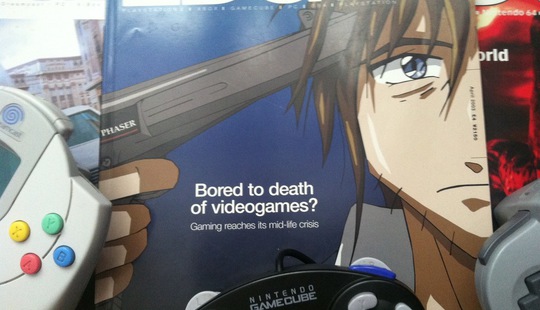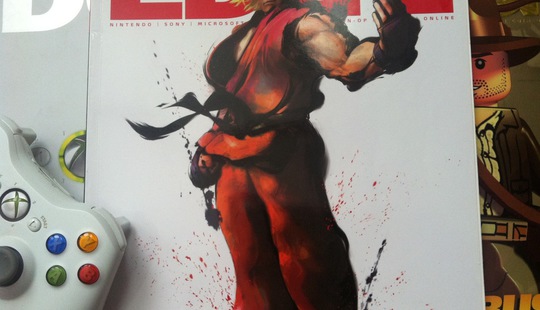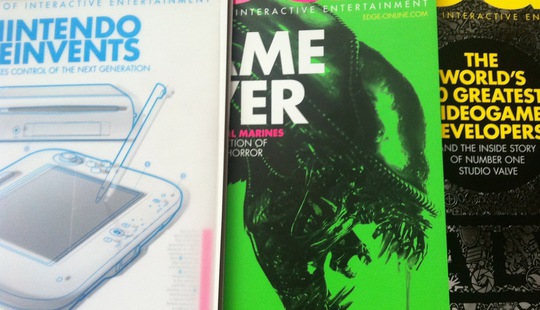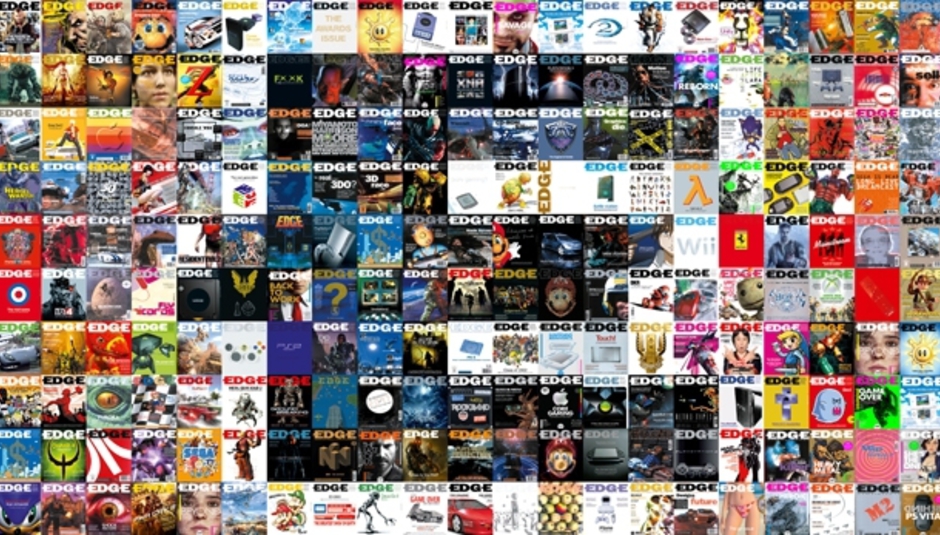For some years now, I’ve not regularly bought music magazines. I know: I’m my own worst enemy, right? But I find that most of what I need, personally and professionally, I can consume online.
There are exceptions, of course. I, like many, would love to see the return of Stevie Chick and Steve Gullick’s Loose Lips Sink Ships; and I would regularly pick up both Plan B and Comes With A Smile (I was fortunate to write for all three, too). The loss of The Stool Pigeon was disappointing, to say the least. But great music writing can be found on the internet. I don’t need to name sites, as you’ll already have your own favourites.
And the ‘net is full of sites focusing on videogames, too. But the problem this particular pursuit has is, it seems to me, anyone can do it – and I do appreciate the irony in writing that given this piece is running on a music-centred site, and is penned by someone better known for contributing opinions on music.
The quality control that exists in music journalism simply isn’t there across a lot of the games press – again, in my opinion. There are great corners of the web covering games with articulate intelligence, going deeper than the majority. But there are an awful lot of big websites – and magazines, for that matter – doing it wrong.
Perhaps it’s because the products reviewed aren’t quite as disposable: it’s perhaps natural to want to appease a PR who services new games retailing at £40 over one sending out promo CDs you can pick up in a second-hand store for a fiver. And perhaps this explains why a site like the Guardian’s dishes out 4/5 scores for games that have, elsewhere, received a deserved kicking. Four stars for Aliens: Colonial Marines? In nobody’s world is that a four-star game.
But I digress. And move swiftly to a veritable bastion of videogames journalism: Edge. The magazine began in October 1993, its first cover featuring the expensive flop that was the 3DO console, and its third the appalling beat-‘em-up, Rise Of The Robots. It’s probably needless to stress that the magazine got a lot better.
Today, it’s the only magazine I have a subscription too. Actually, that’s not true. But it’s the only magazine I receive once per month that I don’t get sent to me for free. And I cannot wait to tear the packaging apart and gaze upon its cover, every time. Inside, guaranteed: the highest-quality coverage of the world-turning hobby that is videogaming.
The magazine has an aesthetic that’s unique, always standing proudly singular against peer-level titles on newsagent shelves; and its writing is of the kind that begs the reader to get stuck into whatever the critic in question is passionately promoting – not because they want to remain in free games, but because this is their love, manifested in a most-perfect form. When your game gets a 9/10 in Edge – as have Dishonored (here) and Bioshock: Infinite (there) recently – you know you’ve done something right on the development side.
That said, it did award Fallout 3 a 7/10. So, y’know… pinches of salt, and that. Maximum scores are rare indeed, the most recent being 2011’s Skyward Sword (here).
Rather than spend this column playing games, then, I’ve decided to speak to the people behind the magazine that, usually, is responsible for me playing them in the first place. What follows: brief Q&As with four individuals who help to make Edge as great as it is, exploring the problems they face and celebrating the goals they achieve. Inevitably, there are parallels to be drawn between the below and the working practices of today’s music press.

Jason Killingsworth, Features Editor
People, Places, Things, in the (back-end) Create section of the magazine, is a favourite of mine, allowing the magazine to get retrospective without being exclusively historical. Do you think that nostalgia is a powerful factor in contemporary gaming, despite the industry’s relative youth?
“Yeah, there’s always a danger of ending up with something like a ‘retro ghetto’, which does a disservice to the material. The fundamentals of good game design don’t change just because you can squeeze a few more pixels onto the screen or take the action into a third dimension. We feel like Pong and Dead Space can and should rub shoulders occasionally.
“Partitioning retrospective game pieces feels like booking your elderly parent into an assisted-living facility, communicating that such games aren’t relevant enough to mingle with younger, perhaps more nubile-seeming game properties.
“To address the question more specifically, nostalgia has always been a potent marketing force. We have a tendency to idealise our childhoods, perhaps because it’s easier to let the distance filter out the less-palatable memories, and any game that helps us connect with that less-worries-laden version of our current adult selves will feel like a welcome retreat.
“But I can say that the Create section is my favourite part of the magazine, both to assign and to read. There’s so much latitude to investigate interesting things when you don’t have to worry about being enslaved by the timeliness of your subject matter. You can just focus on what’s most interesting.”
Edge’s editorial standards are second to none in its field. But just how important is it to the magazine’s fortunes that this side of the brand is never lost to ‘quicker-fix’ web-traffic drives, easier distribution of assets with the ‘me-first’ mindset?
“All the magazines I love have strong, distinct personalities. If you wear a suit and tie to work, you might call it brand identity. Those of us actually stamping words on the page tend to call it editorial voice. Just as you’d get annoyed spending time with a friend who constantly reshuffled their tastes and personality to seem in step with the prevailing fashion, magazines that cultivate enduring loyalty maintain a unified editorial voice, and any freelancer that writes for it will be conscientious about adopting that tone in their writing.
“Edge always wants to be that friend who’s deeply knowledgeable about games, honest, good-humoured and savvy enough about the trajectory of the games industry to be prescient about what’s coming next. If you read any comments about Edge in gaming forums, you’ll know we have some very energetic detractors. I always find that an encouraging sign. It means we have a solid enough identity that there’s something worth feeling strongly about, even if there’s a vitriolic slant to those impressions.”
Here's a Sony fan who clearly thinks Edge has a Microsoft bias...

Mark Wynne, Senior Art Editor
Edge looks great, and has done through a few redesigns now. With the printed edition, just how important is it to absolutely nail that cover? And how important is it to sometimes forsake a truly distinct cover for a more commercially minded direction?
“The old-fashioned logic of putting what we think our readers will find most interesting on the cover makes such discussions pretty moot. Dark Souls II, PS4… they’re all exciting. The conversations at Edge every month are still the same as they were 20 years ago: what’s the best cover feature and how can we make it look amazing?”
How would you best describe the aesthetic Edge offers within its pages? Is it a considered, refined utilitarianism?
“As print magazines struggle to retain their viability, the challenge has become as stark as it was 20 years ago when Edge challenged the nature of games magazines back then: how do you make your magazine relevant? How can paper and ink every few weeks challenge the immediacy of the web and the vitality of digital magazines? There’s a power and authority to those double-page spreads that will always have their own unique merit, an ideal alchemy of language and image when the writer and designer combine to create that perfect hybrid of idea and communication.”
Ease of conveyance is paramount in the online world – text reduced to short(er) paragraphs, clean image implementation – but creativity can be bolder on paper. What are your own design maxims when addressing the layout of each issue of Edge?
“Make the reader stop and engage. Pace spreads to make movement through the magazine varied. Communicate the idea behind the feature as quickly as possible. Don’t be boring. As well as treating games respectfully, Edge always treated magazine design with respect, too. This was a generation who’d fallen in love with games and magazines, and how things looked mattered. Now that everything is more designed – games, magazines, movies, packaging – Edge is reacting to the environment again and maybe trying to design it a little less – or rather, achieve more impact with fewer strokes.”
What consultation goes into the ‘next month’ page, as subtle as they are? I love these little clues, rather than a more explicit approach. But can this actually comprise a thorn in the commercial side? If your subscription is coming to an end, would it be better to know what’s upcoming, to re-subscribe?”
“The next-month pages are often labour-intensive and impractical, and their obliqueness makes them pretty ineffective as drivers for the next issue’s sales. But they reflect the sensibility of the magazine, which is to avoid the predictable and have some fun with the content.”
Moving into the App Store to offer tablet editions is a standard move for publishers right now. How smooth has this process been for Edge?
“Games are fizzing, electronic explosions of pixels and movement that burn through a screen. The iPad edition lets us explore the medium through the medium. Suddenly we’ve got light and movement and a whole new language to play with, to connect us and our readers more closely with the games they love.
“The challenge is not translating Edge to iPad, but creating a new Edge experience that exploits this amazing device. Twenty years after desktop publishing revolutionised the industry, the new digital formats are offering more radical opportunities to make communication and publishing even more rewarding and exciting. It’s like starting again.”
Edge's interactive iPad cover for issue 248

Ben Maxwell, Writer
I saw you tweeting about Edge being a dream job – what for you makes it stand out amongst its competitors?
“I’ve read Edge for 16 or so years now, and I still subscribe even though I get a free copy every month – I can't help feeling like it would be some kind of betrayal to cancel it, which is my own problem to work through. But yeah, Edge made me feel like I was part of this breathless videogame revolution, rather than just an observer. And while I didn't always understand everything in more technical sections like Code Shop, the quality of writing always gave me the energy to struggle through talk of normal mapping and hidden surface removal algorithms. I know what all of that means now, of course...
“It's always had a particularly dry sense of humour, too, which appeals to me. In more youthful times, I’d begin reading each issue by scanning the reviews section for anything that scored below a 4/10 just to enjoy the scathing dressing down Game X would inevitably suffer. Pretty morbid, really, thinking about it now.”
Edge’s reviews don’t carry bylines – is this something that you feel aids the overall brand identity, or does it perhaps take away from the familiarity readers might feel with certain writers? As in, if you like these games that one writer approved of, you’ll be into these, too…
“Even though there are no bylines, I think you can get a sense of different writers' personalities coming through. But while it's evolved over the years, Edge's personality is the one I wanted to spend time with as a reader. And that anonymity's part of what makes Edge's reviews so trustworthy – the writers simply don’t run up against influence or backlash. Reviews and features may have one lead writer, but we work together to ensure that the final result meets the standards we set ourselves. So the lack of byline is appropriate, I think.”
As someone who joined the core editorial team in 2013, how confident do you feel regarding the future of Edge as a printed product? Has its success in the digital space pointed to a future without on-paper editions? Or will magazines always have a place?
“I think magazines, like books, have a long future ahead of them. The e-reader hasn't diminished the appeal of breaking a new book's spine, and tablets can't take away from the excitement of that familiar thud when your latest issue comes through the door each month. And my collection of back issues looks fantastic, even if I keep having to find more shelf space for it.
“But the iPad edition is a hugely important part of Edge, as is the website, both allowing us to deliver additional types of content. But good writing should give you a sense of being with the writer as they play the game – that's something that I think we do really well, and paper works just fine for that.”
As someone who has released music of an under-the-radar nature (Ben co-founded the Motive Sounds label, and is one-third of Mt.), do you feel an easy connection with small, indie developers looking to rival the bigger guns of the gaming world?
“Absolutely! Having spent years trying to get the attention of music journalists, and knowing how exciting it was when a magazine or website I loved took an interest, I feel like I'm paying that forward when someone shows me something I want to write about. And I have a particular penchant for the strange, off-kilter and moving – a spectrum particularly well catered for by indie developers.
“Having said that, I think the differentiation between an indie developer and a major studio is becoming increasingly blurred. It's not just about sales figures, but the quality of games coming from small teams. Kickstarter's particularly interesting here, in that it allows small teams to work with larger budgets, and big-budget teams to work on smaller projects that would otherwise be deemed too risky. ‘Major’ and ‘indie’ are increasingly unhelpful definitions, along with terms like ‘triple-A’. That makes writing about the industry more awkward, but as a gamer, it's fantastic.”
Fez is an indie-developed game which received a 9/10 review from Edge
Tony Mott, Editor-In-Chief
Edge’s position seems to be, outside looking in, one of ‘best in class’ – evidenced by cover design, the depth of content, and the overall ‘feel’ of the publication. Does this marginalise it at all, in so much as fair-weather gamers, or those focusing on one piece of hardware, might immediately be drawn elsewhere, by OTT cover splashes, the word “exclusive” plastered all over other titles?
“I think being marginalised is in the magazine’s DNA. When it was launched in 1993, it was packaged in plain, opaque black plastic. From the newsstand, there was no way of knowing what content would be inside, aside from the fact that it would be about videogames. The packaging was phased out after a few issues, and over time the magazine became more inclusive, but we’ve never worked to any agenda other than our own.”
How does Edge, with its reputation, balance the expectations of its audience with the commercial targets of its publishers, Future?
“The management at Future understands Edge very well, so there’s no pressure to toe a particular line. If it feels right, we run with it, and we’re given the freedom to do that. Obviously it helps that we’ve been doing this for 20 years, so we know our audience and the audience knows Edge. I’m not convinced that we’d be allowed to re-introduce the opaque cover wrapper if we wanted to, but at least the management here would be open to having the discussion.”
How are you finding the move to an interactive, digital edition?
“Producing the iPad edition certainly involved lots of new disciplines. Before we created it I’d never seen a magazine designer write HTML code, for example, but it all worked smoothly. We’ve learnt a lot already, but this kind of digital publishing is still in its infancy and there are lots of opportunities ahead.
“We have all sorts of ideas for the future, and we’re fortunate to have a company behind us that is particularly dedicated to new technologies and publishing opportunities. Even though we’ve already had a good amount of success with the iPad edition, then, I’d say we’re just getting started.”
Edge will celebrate its 20th anniversary later this year. Follow its content - in the magazine, online and on the app - via their website.
NEXT TIME: As this console generation looks to be breathing its last ahead of the introduction of the PS4 and Xbox One, Savage Pixels heads to Seventh Heaven, to highlight some of the very best games to have been issued for the 360, the PS3 and the Wii. We can't forget the Wii. Can we? If you've some suggestions that really must make the cut, I'd love to hear them - please use the comments section below, or you can tweet me, if you're into that sort of thing.






















